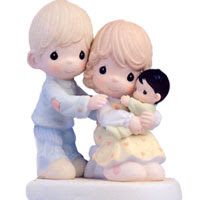These tips were posted on Waiting For Baby Mia and I thought they were great so I borrowed them to share with you.
For those that don't know, there are some things that need to be done a bit differently when bringing home an adopted child.
There are attachment issues to consider. For example, we're told to not allow anyone else to hold the child for the first 4-6 weeks and to lay low, stay home, have very limited visitors. All of this is to help with the critical period of attachment.
All of us adoptive folks have had to read books on this topic, attend workshops, etc. So, we feel pretty comfortable with what needs to be done. However, it's another thing to sometimes try and explain it to friends and family. I have heard of other folks really struggling with it.
There are some great resources out there. But, for those folks that will be part of the community of people welcoming home an adopted child (friends and family), you may want to check out the list of helpful hints below.
It's a list of "Dos & Don'ts" for folks on adoption and attachment. It comes from a site that deals with attachment in adopted children, A4EverFamily .
Dos & Don’ts for Family & Friends of Adoptive Parents
Do
1. Offer household help (running errands, preparing meals that can go right from the freezer to the oven, etc.) so the mother can spend more time holding the child.
2. Trust the mother’s instincts. Even a first time mother may notice subtle symptoms that well-meaning family and friends attribute to “normal” behavior.
3. Accept that attachment issues are difficult for anyone outside of the mother to see and understand.
4. Be supportive even if you think everything looks fine to you.
5. Allow the parents to be the center of the baby’s world. One grandfather, when greeting his grandson, immediately turns him back to his mom and says positive statements about his good mommy.
6. Tell the baby every time you see her what a good/loving/safe mommy she has.
7. When the parents need someone to care for the baby for a night out, offer to babysit in the child’s home. (After the child has been home for a substantial period of time.)
8. As hard as it may be for you, abide by the requests of the parents. Even if the baby looks like she really wants to be with Grandma, for example, she needs to have a strong attachment to her parents first. Something as simple as passing the baby from one person to another or allowing others, even grandparents, to hold a baby who is not “attached” can make the attachment process that much longer and harder. Some parents have had to refrain from seeing certain family members or friends because they did not respect the parents’ requests.
9. Accept that parenting children who are at-risk for or who suffer from attachment issues goes against traditional parenting methods and beliefs. Parenting methods that work for many children can be detrimental to a child with attachment issues.
10. Remember that there is often a honeymoon period after the child arrives. Many babies do not show signs of grief, distress, or anxiety until months after they come home. If the parents are taking precautions, they are smart and should be commended and supported!
Don’t
1. Assume an infant is too young to suffer from emotional issues related to attachment. Babies are not immune.
2. Underestimate a new mother’s instincts that something isn’t right.
3. Judge the mother’s parenting abilities. What looks like spoiling or coddling may be exactly what the child needs to overcome a serious attachment disorder. Parenting methods that work for many children can be detrimental to a child with attachment issues.
4. Make excuses for the child’s behaviors or try to make the mother feel better by calling certain behaviors “normal”. For example, many children who suffer from attachment issues may be labeled strong-willed by well-meaning family members. While being strong-willed can be seen as a positive personality trait, this type of behavior in an attachment-impaired child may signify problems.
5. Accuse the mother of being overly sensitive or neurotic. She is in a position to see subtle symptoms as no one else can.
6. Take it personally if asked to step back so the parents can help their child heal and form a healthy and secure attachment. You may be asked not to hold the baby for more than a minute. This is not meant to hurt you. It is meant to help prove to the baby who his mommy and daddy are. Up until now the child’s experience has been that mommies are replaceable. Allowing people to hold the baby before he has accepted his forever mommy and daddy are can be detrimental to the attachment process.
7. Put your own time frames on how long attachment should take. One mother was hurt when she was chastised by a relative who couldn’t understand…after all, the baby had been home six months. It could take weeks, months, even years. Every child is different.
8. Offer traditional parenting advice. Some well-meaning family members will tell a new mother not to pick the baby up every time she cries because it will spoil her. A child who is at-risk or who suffers from attachment issues must be picked up every single time she cries. He needs consistent reinforcement that this mommy/daddy will always take care of her and always keep her safe.
9. Fall into the appearance trap. Some babies/toddlers with attachment issues can put on a great show to those outside of the mother/father. What you see is not always a true picture of the child. Even babies as young as 6-months-old are capable of “putting on a good face” in public.
10. Lose hope. With the right kind of parenting and therapy, a child with attachment issues can learn to trust and have healthy relationships. But it does take a lot of work and a good understanding of what these children need.
Thanks for reading!
20 years
11 months ago






 Nanchang Time
Nanchang Time


















1 comment:
thanks for sharing that.
Lea
xo
Post a Comment